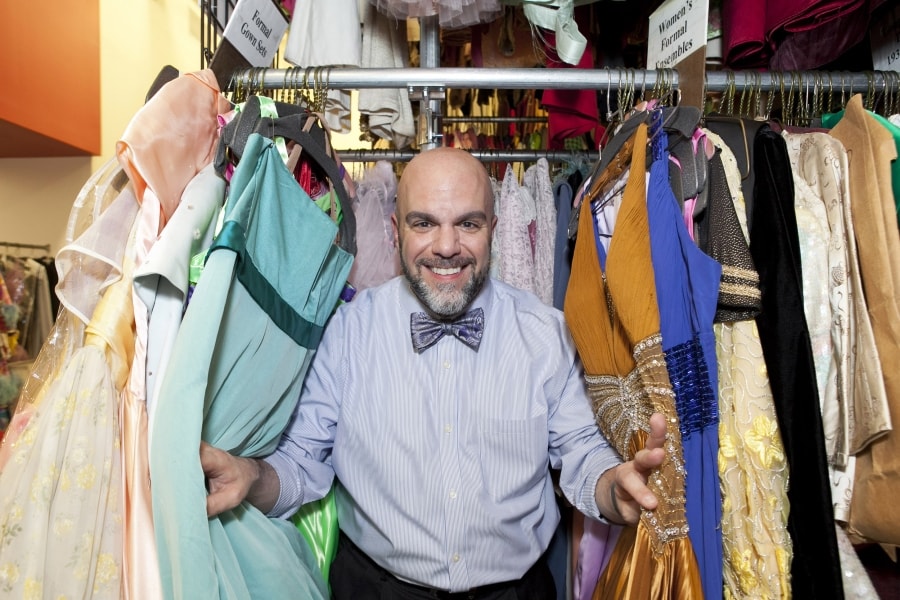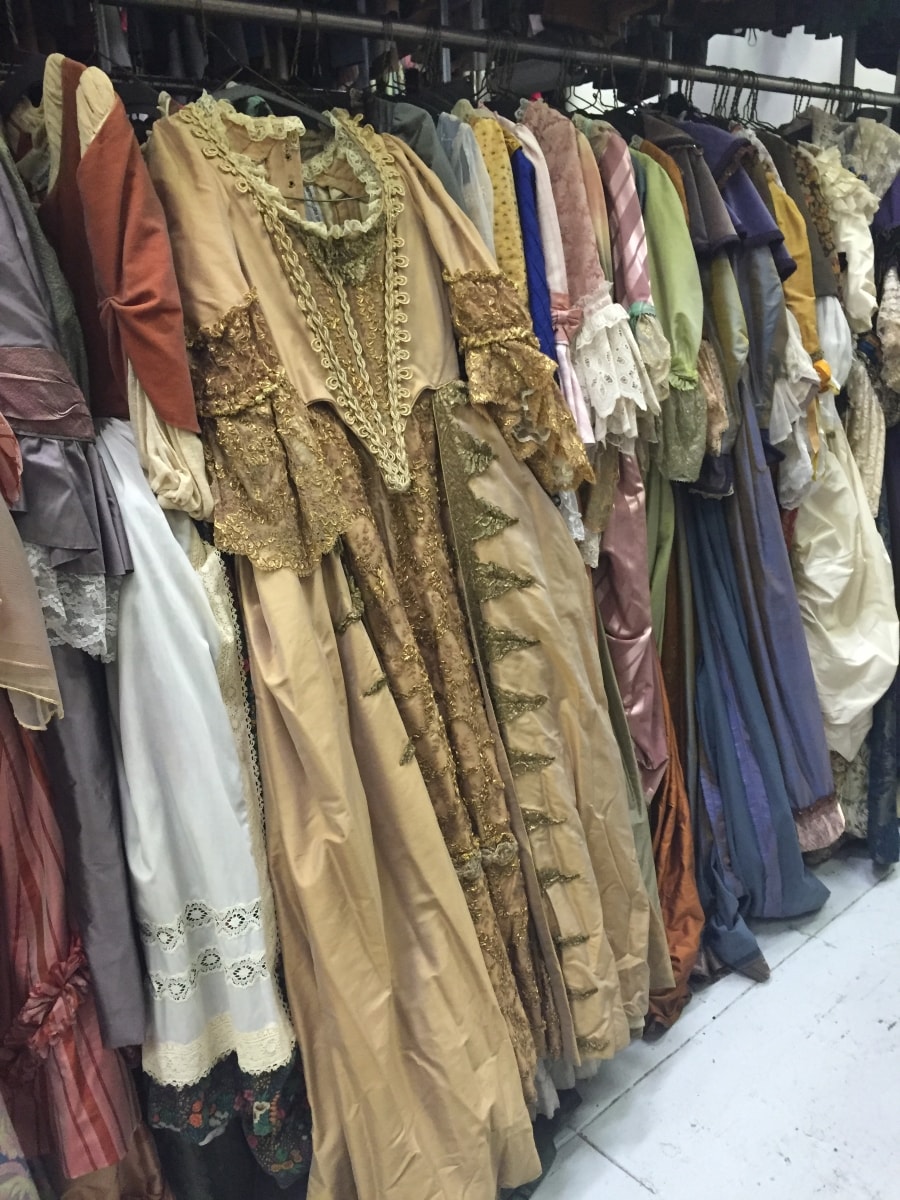“Oh, if only these costumes could talk…”
Stephen Cabral repeats this as he leads me through the impressive home of the estimated 80,000 costumes at the TDF Costume Collection. Housed in a 16,000-square-foot warehouse at Kaufman Astoria Studios in Queens, the costumes—most originally created for theatre and opera productions in New York City—hang in 12 rows 4 tiers high. In the last year, 12,000 of them have traveled to 36 states and appeared in more than 1,000 productions across the country.
“In some ways, most of TDF’s programs are about getting people into the seats,” says Cabral of Theatre Development Fund, which runs Times Square’s TKTS booth, as well as a popular membership program. “Our program is not about getting people into the seats—it is about the experience they have once they are in the seats.”
As the director of the collection, Cabral is a walking encyclopedia of costume history; at a glance he can usually recall where certain costumes came from, many of the productions they were rented out for, even the famous stars who wore them onstage. As we turned a corner, he pointed to an elaborate brocade cape that was donated by the Metropolitan Opera. The weighty piece is one of many in the collection from the Met, the organization that kickstarted the collection with a generous donation in 1969.

Costumes find their way to the collection by way of touring shows, estate donations, and the unfortunate scrap of Broadway costumes in previews—such as pairs of tall military boots I spy on a top shelf that appeared in Hamilton when it was at the Public Theater. No donation is ever turned away, a policy that has amassed bins upon bins of patent leather dress shoes and the occasional gem. Cabral describes the process of sorting through a new donation like Christmas: You never know what piece will come through the doors.
The collection is separated by type of garment and period: Bustles live in aisle 7, flapper fare can be found in aisle 6, Shakespearean styles can be located in aisle 10, etc. The many designations are laid out in a handy map for customers, many who pull the costumes themselves.
“It is a little more leg work for the customers that come in,” says Cabral. “But they can create the show by going to the specific period of the show they need. It allows the designers who come in really great artistic freedom, because they are not taking someone else’s idea of a show—they are pulling their vision of the show.”
On any given day among the racks, Broadway designers mingle with parents volunteering to pull costumes for an elementary school play. For theatres located too far away to travel to the collection in person, the TDF Costume Collection recently began offering the services of an in-house designer who can assist in pulling a show: A costume designer can provide TDF with sketches, research on the production, and the cast’s measurements, and TDF’s in-house designer can pull costumes and ship them anywhere in the United States.
The services rendered by the costume collection thus allow nonprofit theatres to to put quality costumes onstage at little cost. Prices are determined on a sliding scale according to the length of performance and the number of seats in a facility. A costume is defined as anything that an actor can wear at one time, from bootstraps to bonnets.
And while Western hats and Colonial coats can be spotted at church productions and in school auditoriums, costume pieces from the collection also appear in films and on the occasional episode of “Saturday Night Live.” Costumes are rented to commercial projects on the basis of artistic merit—the collection is not the place for social events or high-end Halloween parties to browse, and they’re not allowed to be rented for anywhere that food and drink will be present. In any case, large corporations pay more. “In some ways our commercial rentals are helping to offset the costs of running the place for the not-for-profits,” says Cabral.
As we pass racks of clothing that have already been pulled for shows, I spot a blue silk gown and a row of coat blankets for a production of Gypsy. Nearby hangs a row of curtain dresses and nun’s habits gathered for The Sound of Music.

Next Cabral takes me to the Special Stock Room, a section deemed worthy for brand-new pieces, costumes from notable productions, and pieces built by well-known designers. There I walk between bedazzled suit jackets designed by William Ivey Long for The Boy from Oz and a hand-beaded evening gown by Bob Mackie. There are also some newer, brightly colored fairy-tale dresses and bright green leisure suits—popular items for costume designers looking to jazz up a classic show.
“Everyone is doing their own spin on different period,” says Cabral. “Nobody wants to do a production of Titus Andronicus that looks like a period production of the show.”
But there are also historic pieces in pristine condition, properly swoon-worthy for period productions. I pull out an Elizabethan gown with intricately embroidered sleeves; it is so heavy that Cabral helps to hold it up. The gown was built in the 1970s for the Met, and Cabral shows me the corset stays inside the waist and the adjustable fasteners on the seam that have allowed for the dress to be worn by performers of many sizes. Clearly the Met spared no expense, and the ornate costumes have lived on: Eight tags are sewn inside with different actress’ names.

Customers can gain access to the Special Stock Room if they have rented from the regular stock and followed the rules of the collection, returning each piece within the allotted time and dry cleaned. As we reenter the regular stock room, Cabral shows me a distressed velvet jacket with gold buttons. The piece once lived in the Special Stock Room, and like many costumes, the repeated dry cleaning, sweat under hot stage lights, and gradual wear and tear have moved it through to the regular stock room and into the “distressed” aisle—a haven for designers pulling for Les Misèrables. In a few years, the jacket may appear in one of the two annual bin sales that the collection holds, at which hundreds of customers seeking costumes for high schools and church plays pay a flat fee to fit as many pieces into a bag. It’s an event that sometimes dictates what shows a given organization is able to produce that year. Other designers sort through the recycled pieces with measurements in hand, pulling specifically for productions.
The loudspeaker sounds that it’s almost closing time, and costume designer Kate Mincer scurries to gather helmets from a bin. She is pulling pieces of armor for a Nine Inch Nails-inspired dystopian Rome production of Julius Caeser in Stonington, Me. The TDF Costume Collection is one of many places that she has come to gather armor pieces that are too difficult to build. “It is possible to put together a really sophisticated show and to give the audience what they want to see,” says Mincer about her many trips to the TDF Costume Collection over the years.
“This is the type of situation that is a big portion of our business, where designers are not getting the entire show here,” Cabral adds. “People are getting the portion that is impossible to build, or the portion that is too expensive to build.”
Mincer says she plans to ship the the unwieldy armor up to Maine, another helpful service provided by the collection.
Before I depart, I try on a massive hat from the Christmas Spectacular Show at Radio City Music Hall; judging from the ruffled feathers, it made its debut many Christmases ago. I’m reminded of that feeling an actor has when they first try on their costume—that simultaneous sense of transformation and ownership, as the clothing changes you and you take that on. At the costume collection, that feeling is elevated—after all, the hat on my head was worn by Rockette. And who knows? The dress you may try on just may have been created for Carol Burnett.





